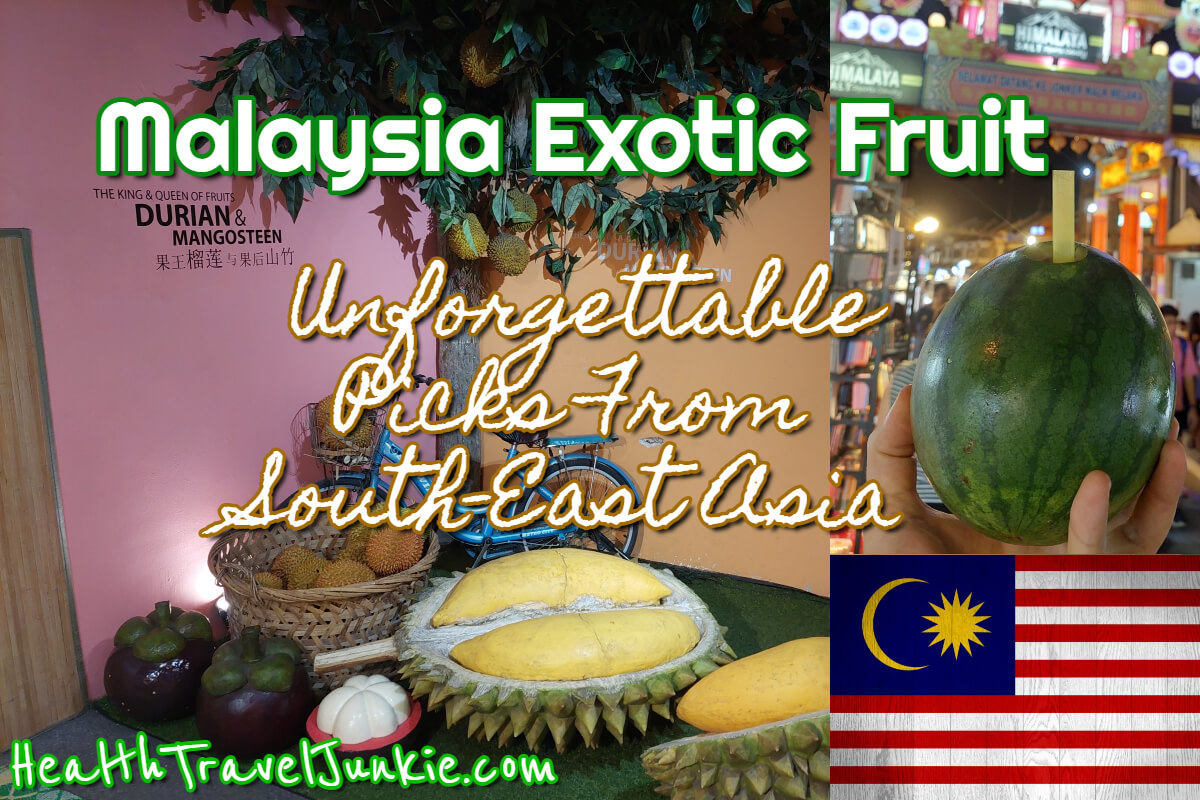Malaysia has some of the world’s tastiest exotic fruits. These are mostly tropical fruit, due to the hot and humid tropical climate of South East Asia. To be exact, since Malaysia is situated just north of the equator, its an Equatorial climate.
There’s a lot of overlap between exotic fruit in the different countries of South East Asia, e.g. Thailand, Cambodia, Indonesia, or Philippines. However, I’m specifically referring to Malaysian exotic fruit in this article. When in South East Asia, be sure to sample the below fruits!
Contents
Longans
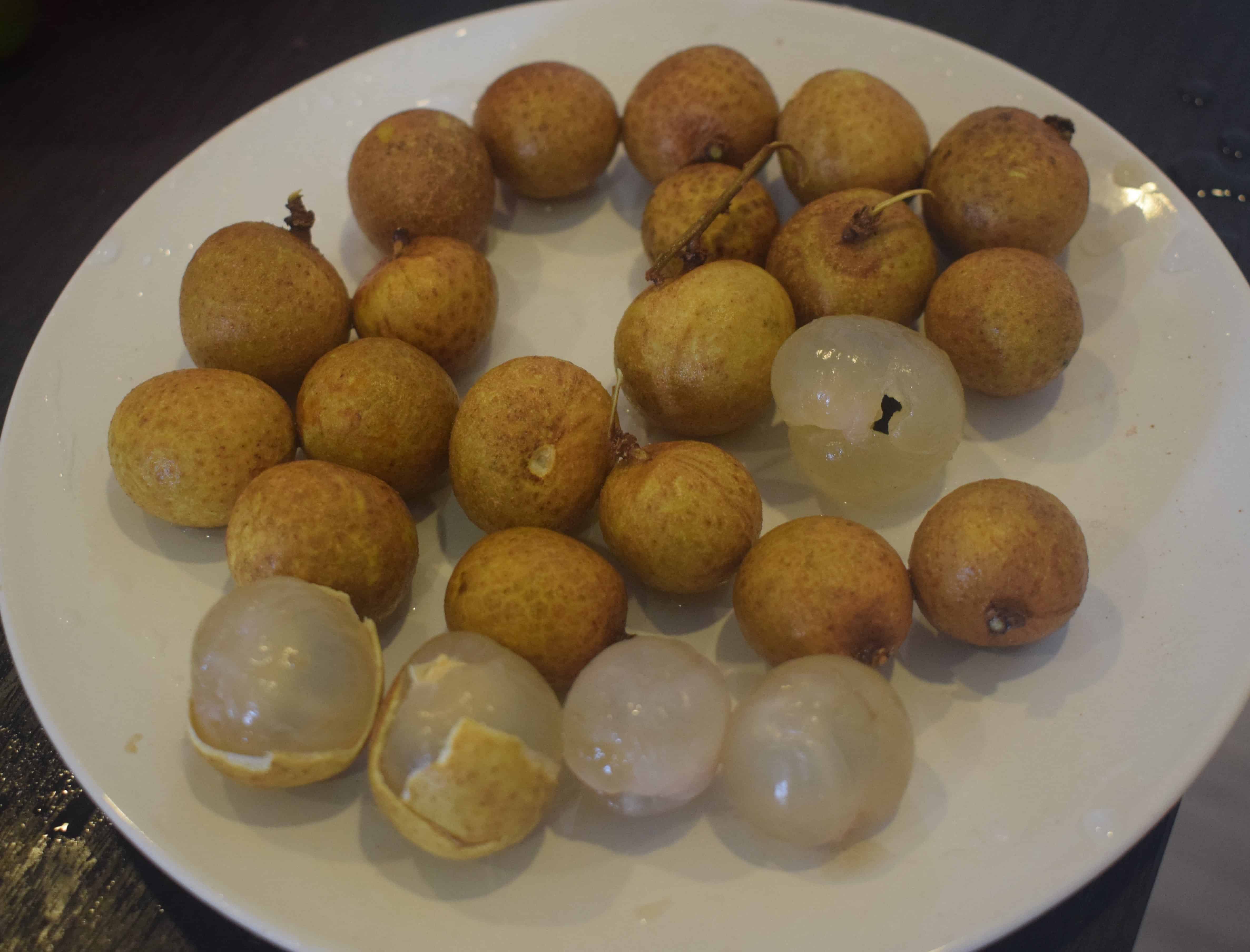
Longan is a very popular fruit in Kuala Lumpur. It grows abundantly on Longan trees and its cheaply available everywhere in Malaysia.
Longan tastes similar to Litchi. But it’s a smaller fruit, with a smaller seed and flesh. The external skin is smooth, while Litchi is rough-skinned. Longan is delicious, and I highly recommended to try it.
In Malaysian Supermarkets you’ll find dried Longans – a popular ingredient in Asian soups and desserts. Or simply eat it as an energy snack on the go, similar to raisins in the West. If you’re not in Malaysia, check out this popular brand of dried longans over at I-Herb (with international shipping).
Longans contain anti-oxidants such as Vitamin C, Iron and Potassium.
Duku Langsat
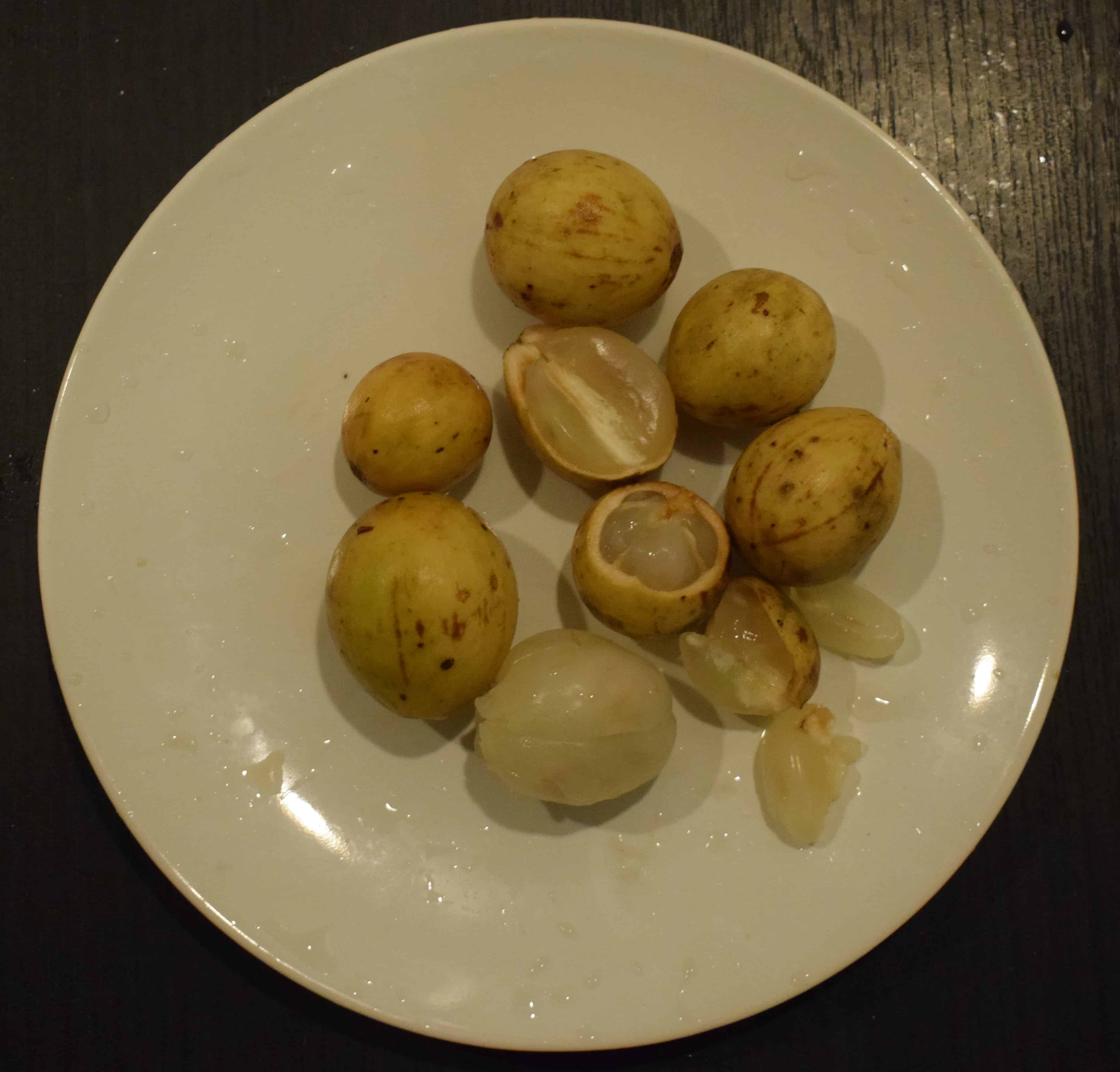
In the tribes of South East Asia, where they live closer to nature, fruits like Duku Langsat is a healthy alternative to the West’s “candy” obsession.
Similar in shape to Longan, Duku Langsat is a nutritious fruit with an unique, delicious taste.
Duku Langsat is a little harder to find in Malaysia than Longan. It seems to have a shorter harvesting season. Plus, shorter shelf-life is another reason why grocery stores often don’t stock these super-tasty fruits.
I prefer Duku Langsat’s unique sweet and slight tart and sour taste, above Longan. This is one of my favorite fruits of all time. Too bad Duku Langsat trees wouldn’t grow outside the tropics.
Rambutan
Rambutan is only available in Tropical regions of the world. This includes Asia, but also South America. Over there it’s known as Achotillo. Under this name, I’ve also mentioned it in my Ecuador Fruit Guide.
In Malaysia the word Rambutan means hair, of course due to the hairy protective outside red husk.
Either pry the Rambutan open with your nails, or twist it open with the hands. The inner flesh is white like Litchi and Longan.
Rambutan is harder and more firm than a Litchi (both the outside and inside). Yet its definitely still very tasty. Chuck a few in your backpack when you go camping or hiking.
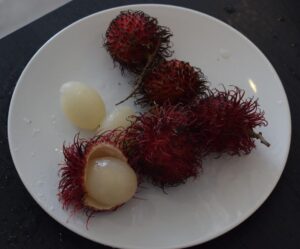
Predictably, it’s another nutritious fruit. Then again, all fresh fruit are nutritious. In Rambutan, expect abundant Vitamin C, Fiber, Potassium, a few B-Vitamins, Magnesium and Calcium.
Mango
I’ve yet to travel in a country where there wasn’t mangoes available. Despite being a tropical plant, it’s easy to transport mangoes while green. Then it stays green if you keep it refrigerated. Ripen the mango at home by keeping it two or 3 days at room temperature.
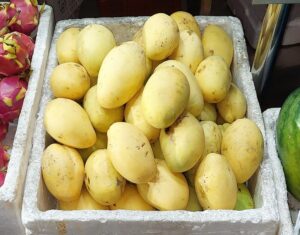
There are plenty more types of mango in tropical Malaysia than in Western Countries. This ranges from small to large, plus different color skins. However, the inner flesh is always the same trusted taste and yellow colour.
Apart from more varieties, Malaysia also has more applications for mango:
- There’s South East Asia’s favourite dessert: Mango Sticky Rice with Coconut Milk. This is really easy to make at home. You need rice plus sliced mango, then add coconut milk mixed with natural brown sugar on top.
- Mango Smoothie. This is usually 100% pure mango with added ice. At home you could also add Chili to the blender (see my Mango-Chili smoothie recipe).
- If you like these spicy flavors, try the mango slices in a plastic cup, sprinkled with Chilli as in the photo below.

Kedondong
This is the least tasty fruit in this guide. It’s simply not sweet enough to eat as is. In English, it’s also known as Ambarella or Sour Plum.
The flesh is kinda firm, but it has a slight mango taste and resemblance. Which is why it’s sometimes presented with sliced Mango along with chili spice as a Malay snack (see photo above). Despite not tasting that good, it’s still highly nutritious. You simply gotta be creative in how you consume it, e.g. some also juice or pickle Kedondong.
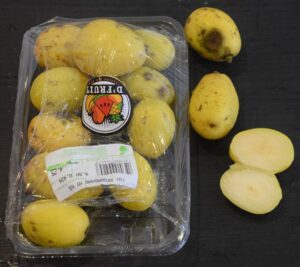
JackFruit
Jackfruit is a great tasting snack. Remove the smaller yellow fruits from inside of the large green Jackfruit.
Young green jackfruit is used as a meat replacement for vegetarians, e.g. it can work as part of a Thai Curry. Although jackfruit is hard to find outside the tropics, it’s easy to buy canned green jackfruit at Amazon, or locally at Asian stores and good health shops.
Moreover, ripe jackfruit is sold as a dried snack. I prefer only to eat fresh jackfruit. Dried fruit has more calories. Plus you tend to eat more than you otherwise would if it was fresh. In addition, its less nutrient-dense than fresh fruit since vitamins diminish as time passes (during drying and storing).
With its bright yellow colour, fresh jackfruit predictably contains good levels of Vitamin A, helpful for eyesight.
Ideally the Jackfruit should be ripe, but not over- nor under-ripe. It’s not always easy to tell for an untrained eye whether the fruit is ripe yet (especially not for Westerners outside the tropics).
The below jackfruit is very ripe. I cut it open the same day after buying it at the grocery store. It tasted great, so it wasn’t “spoiled fruit”. But ideally the flesh should be more firm.
Below is a less ripe half-jackfruit with more firm flesh. The mini-jackfruits don’t simply pop out when less ripe. But its the best way to consume it. Sometimes the street vendors use knives to shave off the white strings from the yellow jackfruit pods. Then the ripe yellow pods are put in a plastic container as below.
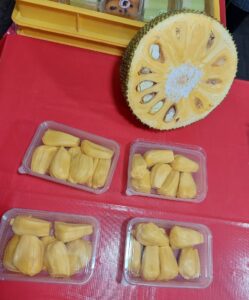
The small yellow jackfruit in the plastic containers are cheap and tastes great. It’s like a firm version of mango with sweet custard notes. On the other hand, whole green jackfruit can be expensive as it’s a massive fruit.
Durian
There are more than 200 known species of Durian in Malaysia. Its a sweet creamy fruit eaten like a dessert. It’s one of the more expensive fruits in Malaysia. The fruit can have a strong smell, thus some hotels and hostels prohibit Durian in the rooms. I like the exotic fruit smell. But if you’re not into a healthy lifestyle and clean diet, you may not enjoy the smell.
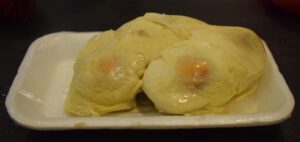
There are different Durian varieties in Malaysia, and some fetch sky high prices. But in December 2022 I bought a small Durian at Jalan Alor Food Market in Kuala Lumpur for $8.50. Durian would’ve been a great smoothie ingredient if it was cheaper.
Some shops sell freeze-durian, but it’s very expensive as well. Extremely delicious though, like a melt-in-your-mouth texture.
The reason for Durian’s higher price is because transport is more expensive – its a larger fruit with limited shelf-life. Plus, the number 1 reason: Demand exceeds supply. There’s no quick solution. As Durian trees take many years to bear sufficient fruits to meet demand. This is along with risks of natural disasters like storms damaging the plantation.
Durian is an incredibly nutritious fruit, containing plenty of vitamins and minerals. Thus you do get some bang for your bucks.
Banana
Regular banana is a very ordinary fruit, but there are many different types of Banana in Malaysia. In the West, we are mostly accustomed to one or two varieties with very long shelf-life. But Malaysia has bunches of tiny bananas, red-skinned banana, green plantains which can only be cooked, larger sweet ones, and so on.
One of the most famous Malaysian Desserts is Pisang Goreng. This is deep-fried bananas covered in a rice flour batter.

Snake fruit
Snake Fruit is known as Salak among locals in Asia. The skin of the fruit is leathery like snake-skin. It has a few fruit segments on the inside, plus a large brown pit in the middle.
Snake fruit tastes decent, but not great, when its ripe. It’s a little sweet, but definitely not as sweet as e.g. Jackfruit. The taste is also faintly reminiscent of Pineapple. The slightly bitter or acidic taste may be the reason snake fruit never took off in popularity beyond South East Asia. However, there’s around 30 different types of Salak. Thus your taste experience may differ from mine.
The Snake Fruit grows above the ground at the base of the trunk of a Salak palm tree. It’s especially widespread in Indonesia, but also grows in Malaysia.
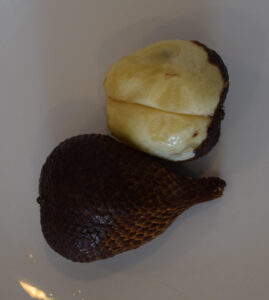
Snake Fruit contains Calcium, Vitamin C, Beta-Carotene, Potassium, amongst other anti-oxidants. Plus, it is known for its anti-diarrheal effect.
Miniature Asian Citrus Fruits
So to be specific, this can be mini-tangerine, mini-mandarin, mini-orange, mini-lemon, or kumquat (where you also eat the skin). These tiny citrus fruits tastes exactly like the larger versions. Its easy to peel, then pop it whole into your mouth. It’s a great snack. An unusual, but popular fruit of Kuala Lumpur, available in the supermarkets.
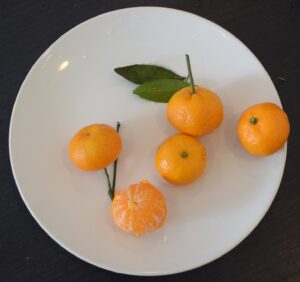
Why not grow a dwarf citrus tree on your skyscraper apartment balcony in Kuala Lumpur? This would be like having 100% natural Vitamin C pills at your disposal in fruit form.
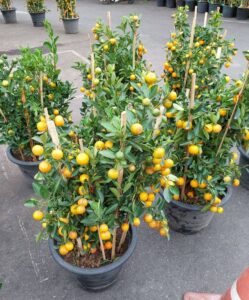
Rose Apple
The texture and taste is similar to a crispy regular apple, though it does look different. If you like regular apples, you’ll probably also like Rose Apples. Pros: The flesh has a slight Rose aroma. Cons: In my opinion, it has a more bland taste than regular apples.
This is a niche fruit, which won’t be loved by everyone. But it has further applications in jams, sauces, juicing, wines, and so on.

Dragon Fruit
Malaysia has these massive red, perfectly round dragon fruits, with sweet purple flesh.
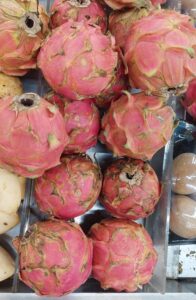
For the Malaysian night-market cravings, pre-cut dragonfruit cubes in a cup is a good choice. In Thailand, I wouldn’t eat any pre-cut fruit. For hygienic reasons it’s safer to cut your own fruit. I got sick in Patong (Thailand) from eating their streetfood with notorious low hygiene standards. Yet Malaysia seemed to have better streetfood hygiene. Especially Jalan Alor food market in Kuala Lumpur where I bought below dragonfruit cup – a sweet and delicious natural dessert.
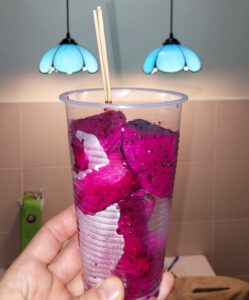
A friend used to grow dragon fruits in his Cape Town backyard garden, which is not even a tropical climate. It’s a healthy organic fruit (with seasonal free supply) if you’ve got a decent-sized backyard. …Or like a free natural medicine, considering the rich nutrient content.
Papaya
Papaya is a famous and widely available tropical fruit. Apart from the delicious orange papaya flesh, you can also eat the seeds. Or blend it in your smoothies for extra vitamins. The only caveat is pregnant women should avoid unripe green papaya and papaya seeds.
It’s not possible to juice papaya, but the flesh tastes great in smoothies with added ice.
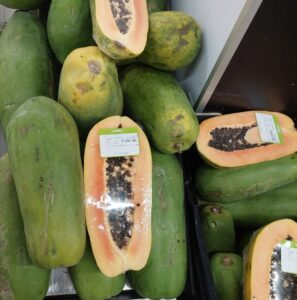
Watermelon
A good question is if the color of the fruit really impacts the taste? By using your imagination you could say there’s a bit of a custard taste to Yellow watermelon, in contrast with regular red watermelon.
Anyway, most will agree it tastes pretty good. I got this yellow watermelon at a Kuala Lumpur Supermarket, and did not regret the purchase.
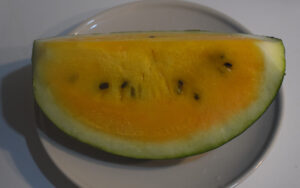
In Malaysia, smaller red watermelons are blended on the spot into a smoothie by streetfood vendors, inside of the green shell. This is Malaysian creativity on display as you’ll see in this youtube short:
Every Country certainly has their own idea of creativity. I also have mine, check my own Watermelon Smoothie Recipe here.
Ciku Fruit
Ciku is originally from Southern Mexico and Central America, where it goes by name variations of Sapote / Sapota / Zapota / Sapodilla. But it also grows well in Tropical Malaysia.
The flesh is silky smooth, and deliciously sweet like a dessert. Ciku tastes like a peach blended with a pink guava and notes of custard. As you can see below, there are a few small black seeds inside. When the skin is slightly soft to the touch, it’s ready to be eaten.
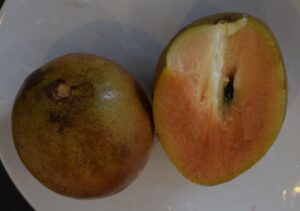
Malaysian Guava
Malay Guava is larger in size and more firm than the regular guavas we know in the West. The white flesh also tasted less sweet than small pink-fleshed ripe guavas. Similar to an apple, Malaysian street vendors often juice the large guava. This is not something that’s doable with small pink guavas as there’s not enough water and fluid inside. But with the below guava, the juice tastes great, and has a green color.
Malaysia also imports the smaller pink guavas from Thailand. But below is the authentic Malaysian Guava – locally known as Jambu.
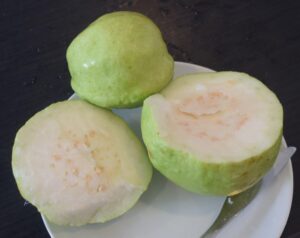
Conclusion – Malaysian Exotic Fruit
Corporations try to brainwash you with large marketing budgets to eat sweets and junkfood. Meanwhile Fruit is cheap, healthy, and widely available. Especially in Tropical countries like Malaysia, with some of the best tasting exotic fruits in the world.
Above is not an exhaustive list of Malaysian fruit. For example, Passion Fruit (Granadilla) and Pineapple are other great-tasting local options. But its too famous to care about including in this article. Persimmon, Coconut, Starfruit, Cape Gooseberries (mentioned in my Cape Town Fruit guide), the list goes on. I’ll leave those for future updates to this article should I ever return to Malaysia.
Which are your favorite Malaysian exotic fruits? Comment below with questions, tips and suggestions to other readers!

